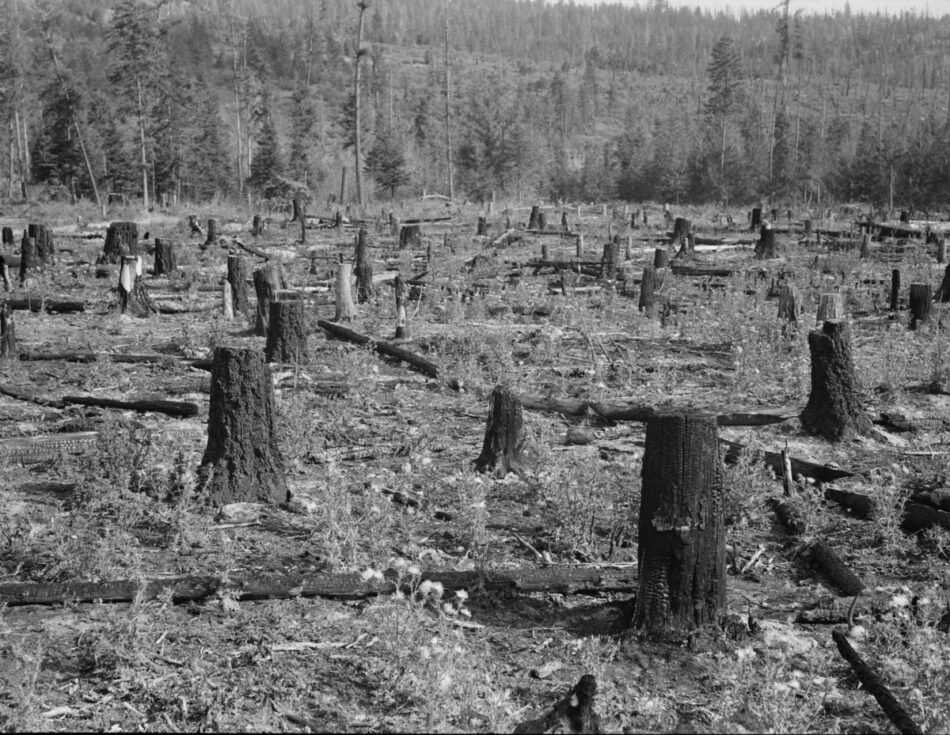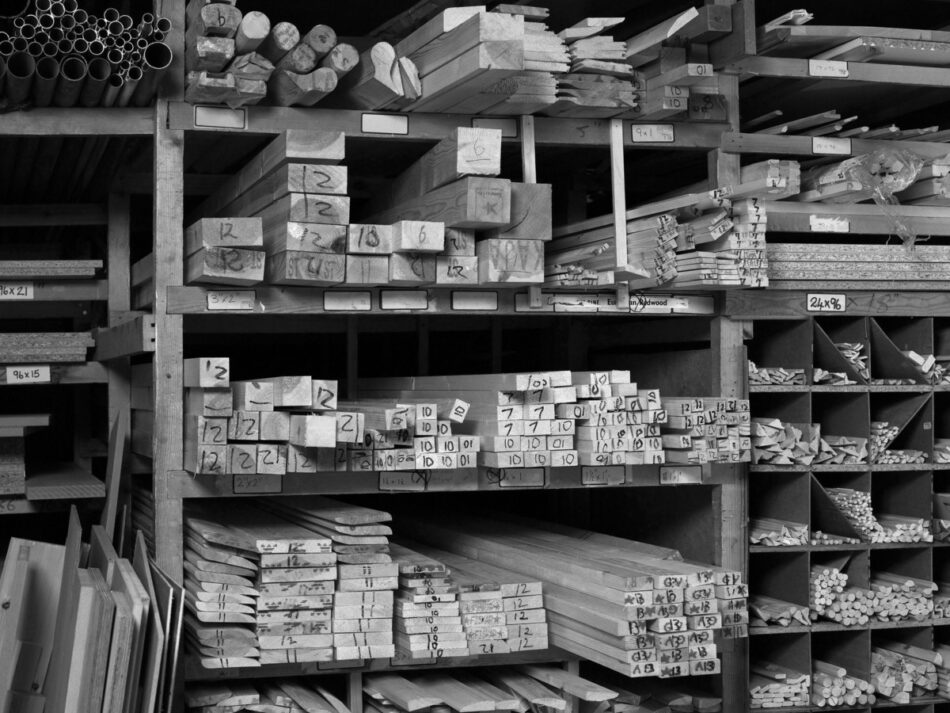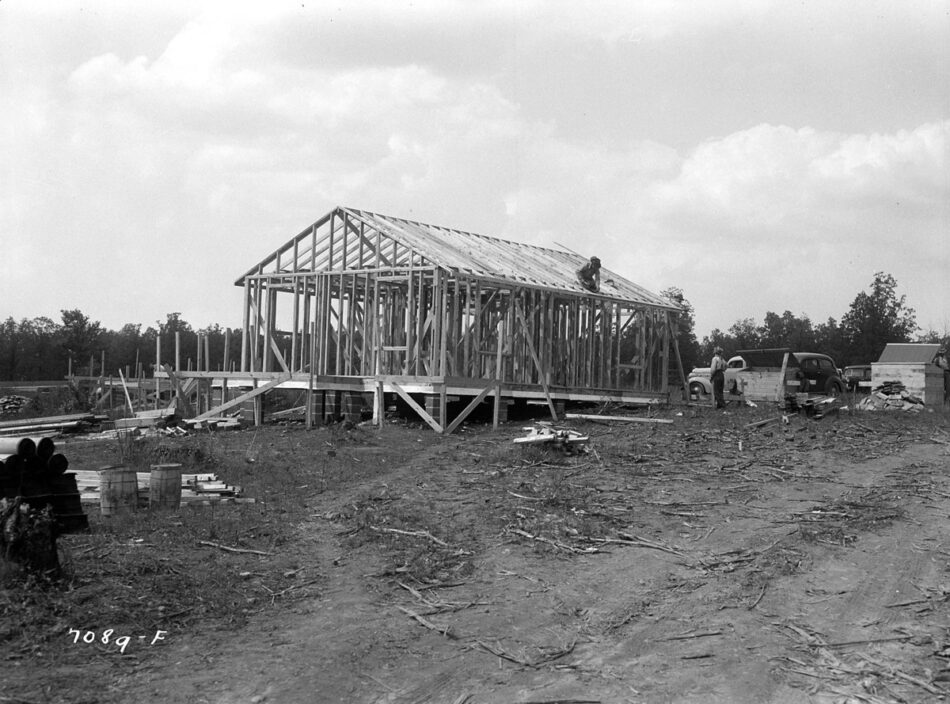Nominal Versus Actual: A History of the 2×4
The ubiquitous lumber product known as the 2×4 does not, in fact, measure two inches thick by four inches wide. The naming of this building material is the result of compromise between forestry technology, species’ properties, forest composition, transportation efficiency, construction speed, and price competition. To accurately reflect its dimensions, the 2×4 should be renamed the 1½ x 3½.
An obsessive concern for material efficiency in the United States, the dominant global user of light-stick framing (also known as 2×4 stud construction), has driven the use of the 2×4 and its resultant commodity homogenization. Before industrialized wood production, which began around 1870, trees were felled, skidded, sized, and made to order for carpenters. Sizing tolerances varied, thus leaving final measurements to site construction. Trees were grown and used locally. North American forests seemed an unlimited resource for almost everything. As trees were harvested, however, human ecology transformed forestland into farmland with landscapes deforested for many generations to come.
Available forestland, therefore, moved toward the hinterlands as nearby areas were cut over. Supply and demand concentrated around the major port cities of New York, Baltimore, Boston, and Philadelphia. Prime forestland—determined by tree size, species type (originally and exclusively white pine), and access to transportation—was changing. Trees were floated out of their watershed, breaking the link between lumberman and carpenter. Rivers, canals, and lakes, made Bangor, Albany, and Chicago wholesale timber capitals. With the advent of the railroad in the 19th century, transportation options and demand for wood increased. Lumbermen purchased vast areas of forestland in the north, south, and west of the country. A new phenomenon was born: species intermingling at market.

Competition occurred among regions, or more fundamentally, among species. For example, southern pine forests called “pineries”—consisting of shortleaf pine, slash pine, longleaf pine, loblolly pine, and other less common species (collectively known as southern yellow pine, SYP)—were pitted against western Douglas fir, western hemlock, and spruce forests. Buyers needed convincing to purchase lumber from unfamiliar species, and hence marketing focused on differentiating attributes such as ease of use, workability, strength, load capacity, and grain movement. The phenological and physiological variability among species was influencing purchase economics.
At the turn of the 20th century, lumber was commonly sold FOB—free on board, with the purchaser responsible for shipping—as it is today. According to the US Department of Agriculture’s “History of Yard Lumber Size Standards,” shipping charges, determined by distance traveled and weight, doubled the cost of lumber. Thus, the physiological variables of density and moisture began to have an outsized impact on forestry economics. Lumbermen favored thinner, lighter sizes for longer hauls. They produced optimal finished sizes of preferred species by kiln drying to control moisture content. And they influenced manufacturers’ associations to prescribe commercially advantageous sizing rules. The 1909 textbook Construction Superintendence acknowledged that lumber classification was “a matter of judgment” and cited lumber inspection rules for three areas that they considered to be major centers: Saginaw (west), Maine (east), and Baltimore (south).
Other factors also drove the market toward smaller sizes. The same steam engine technology that powered the railroad, for instance, enabled the newly invented circular saw to achieve faster, continuous cuts in the sawmill. This development coincided with the mid-19th-century evolution of building framing—from timber-braced to light-stick balloon and its derivatives—which progressively utilized greater amounts of “small dimension stock,” like 2x4s. And the differences in how lumber was sized, surfaced, and dried became apparent in the lumberyard, where a medley of species in various dimensions claimed to be 2x4s. Lumberyards demanded uniformity so that builders could compare cost and quality. As retailers clamored for more regulated measurements and standards, trade associations were formed.

In April 1919, attendees of the first American Lumber Congress called for size and terminology standardization. However, disagreement about specific considerations persisted for decades. In the meantime, demand for ammunition pallets and crates during World War II created lumber shortages. Postwar housing required even more lumber. Foresters and economists faced pressure for maximum utilization. Engineers promoted light-stick framed construction with plywood sheets (and later oriented-strand boards) because it used smaller sticks efficiently. The limited availability of lumber and the rapid pace of housing construction made other methods like concrete-block housing viable. This pressured further compromise because thinner 2x4s were a way to compete in price with wood alternatives. Size standards, maximum moisture content, and nomenclature were agreed upon only as recently as 1964. The nominal 2×4 thus became the actual 1½ x 3½, imperceptibly, a fraction of an inch at a time. It was a 34 percent reduction in actual volume; as those in the trade would say, it’s “selling air.”
Today, everyone in the construction industry knows that nominal size is not actual size—despite the fact that the 2×4 designation persists in the marketplace. So, why does the awareness about the “slimming” of its actual size matter? For one,we must dispel any notion that the current size is a perfect utility equation of structural performance in terms of strength-to-size ratio. Instead, let’s recognize that the evolution of the 2×4 resulted from economic compromise based on simplifying differences and creating a nationwide standard for customers. It is utility optimized for construction speed—speed in shooting together single-family light-stick stud homes which represent more than 90 percent of the residential housing market.
As we search for alternatives to this construction logic, such as timber stacking, hybrid wood-concrete composites, and cross-laminated timber, we should also challenge our adherence to the actual 1½ x 3½ and its shelf-space edge. To recognize this constraint is one way to discover ecologically motivated systems with better impacts on society. Perhaps we should return to a species-based synthesis of growth, harvest, usage, and aesthetics. This type of approach unifies forestry and architectural practices toward a new coherence of words and actions.

Oliver J. Curtis is an independent researcher who explores coherence among ecology, technology, and design. He is a consultant to the Pinchot Institute for Conservation regarding forest supply chain sustainability. He is a contributing author to Wood Urbanism: From the Molecular to the Territorial (2018).
